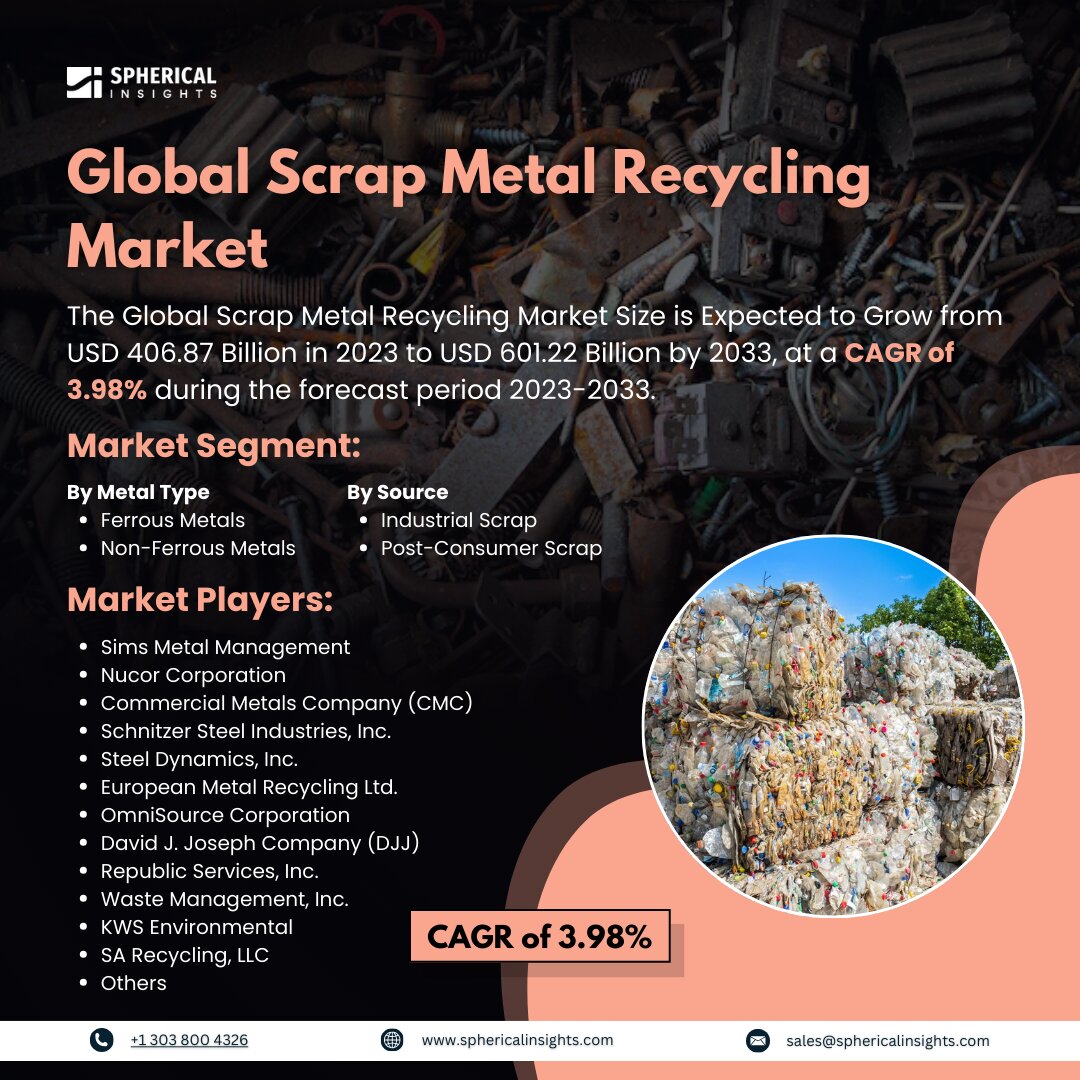Global Scrap Metal Recycling Market Size to worth USD 601.22 Billion by 2033
According to a research report published by Spherical Insights & Consulting, the Global Scrap Metal Recycling Market Size is Expected to Grow from USD 406.87 Billion in 2023 to USD 601.22 Billion by 2033, at a CAGR of 3.98% during the forecast period 2023-2033.
Browse key industry insights spread across 210 pages with 110 Market data tables and figures & charts from the report on the Global Scrap Metal Recycling Market Size, Share, and COVID-19 Impact Analysis, By Metal Type (Ferrous Metals and Non-Ferrous Metals), By Source (Industrial Scrap and Post-Consumer Scrap), By Application (Building & Construction, Automotive, Equipment Manufacturing, Packaging, Consumer Appliances, and Others), and By Region (North America, Europe, Asia-Pacific, Latin America, Middle East, and Africa), Analysis and Forecast 2023 – 2033.
The process of recovering and processing waste metal to produce new, usable metal products is known as scrap metal recycling. This approach is essential for reducing energy consumption, protecting natural resources, and lessening the negative environmental effects of metal production. The recycling process involves collecting scrap metal from various sources, sorting it using advanced technologies, and cleaning it for melting. This process creates molten metal, which can be used in various applications like car manufacturing and infrastructure construction. Recycling metal is highly energy-efficient, requiring less energy than producing new metal from raw ore. It also reduces mining demand, minimizing habitat destruction and greenhouse gas emissions. Recycling is a crucial part of sustainable resource management, supporting environmental conservation and economic growth. The global scrap metal recycling market is witnessing tremendous expansion on account of the increased demand for recycled metals from various end-use sectors such as construction, automotive, shipbuilding, and electronics. Metals including iron, copper, aluminum, and lead are being recycled more and more because of their extensive industrial use. However, the global scrap metal recycling market faces challenges due to fluctuating scrap metal prices, affecting profit margins and requiring companies to adopt accurate pricing and hedging strategies.
The ferrous metals segment is predicted to hold the highest market share through the forecast period.
Based on the metal type, the scrap metal recycling market is classified into ferrous metals and non-ferrous metals. Among these, the ferrous metals segment is predicted to hold the highest market share through the forecast period. Ferrous metals like steel and iron have long been the mainstays of the building and manufacturing sectors because of their strength, malleability, and corrosion resistance. As a result, they produce the most scrap at the end of product lifecycles and during various manufacturing processes.
The industrial scrap segment is anticipated to hold the largest market share during the projected timeframe.
Based on the source, the scrap metal recycling market is divided into industrial scrap and post-consumer scrap. Among these, the industrial scrap segment is anticipated to hold the largest market share during the projected timeframe. Industrial manufacturing processes involving non-ferrous metals like lead, copper, and aluminum produce large amounts of metal turnings, fines, and dross. Strict control of these wastes is crucial for manufacturers' costs and environmental compliance, as they also produce process-tied scrap concurrently.
The building & construction segment is anticipated to hold the greatest market share during the projected timeframe.
Based on the application, the scrap metal recycling market is divided into building & construction, automotive, equipment manufacturing, packaging, consumer appliances, and others. Among these, the building & construction segment is anticipated to hold the greatest market share during the projected timeframe. A significant user of metals like copper, steel, iron, and aluminum is the building sector. Buildings and infrastructure are supported by structural I-beams and steel and iron rebar. Copper and aluminum are being utilized more and more in wiring, roofing, and façades because of their conductivity, ductility, and resistance to corrosion.
Asia Pacific is estimated to hold the largest share of the scrap metal recycling market over the forecast period.
Asia Pacific is estimated to hold the largest share of the scrap metal recycling market over the forecast period. Strong government initiatives that support recycling and trash management, such as the National Non-Ferrous Metal Scrap Recycling Framework, are to blame for this. Large amounts of scrap are produced by industry and construction in nations like China, India, and Japan. As people's knowledge of environmental issues grows, governments are subsidizing recycling businesses to cut down on landfill garbage.
Asia Pacific is predicted to have the fastest CAGR growth in the scrap metal recycling market over the forecast period. The industrialized and urbanized region is encouraging scrap metal recycling through incentives and state-level regulations. Businesses with a sizable industrial base, such as Sims Metal Management and Schnitzer Steel, have set up effective logistics and recycling infrastructure.
Competitive Analysis
Major key players in the scrap metal recycling market include Sims Metal Management, Nucor Corporation, Commercial Metals Company (CMC), Schnitzer Steel Industries, Inc., Steel Dynamics, Inc., European Metal Recycling Ltd., OmniSource Corporation, David J. Joseph Company (DJJ), Republic Services, Inc., Waste Management, Inc., Ferrous Processing & Trading, TMS International Corporation, KWS Environmental, and SA Recycling, LLC, and Others.
Recent Development
- In October 2024, the SCRAPMASTER 400 is a new screening device from MDS that was created especially for the scrap and metals recycling sector. A wear-resistant push feeder, a sturdy drum frame, and auto-reverse capabilities on the drum are some of the characteristics that this machine offers to address durability difficulties that are frequently faced in metal processing. Enhancing the efficiency and dependability of scrap processing is the goal of the SCRAPMASTER 400.
Key Target Audience
- Market Players
- Investors
- End-users
- Government Authorities
- Consulting And Research Firm
- Venture capitalists
- Value-Added Resellers (VARs)
Market Segment
This study forecasts revenue at global, regional, and country levels from 2023 to 2033. Spherical Insights has segmented the scrap metal recycling market based on the below-mentioned segments:
Global Scrap Metal Recycling Market, By Metal Type
- Ferrous Metals
- Non-Ferrous Metals
Global Scrap Metal Recycling Market, By Source
- Industrial Scrap
- Post-Consumer Scrap
Global Scrap Metal Recycling Market, By Application
- Building & Construction
- Automotive
- Equipment Manufacturing
- Packaging
- Consumer Appliances
- Others
Global Scrap Metal Recycling Market, By Regional Analysis
- North America
- Europe
- Germany
- UK
- France
- Italy
- Spain
- Russia
- Rest of Europe
- Asia Pacific
- China
- Japan
- India
- South Korea
- Australia
- Rest of Asia Pacific
- South America
- Brazil
- Argentina
- Rest of South America
- Middle East & Africa
- UAE
- Saudi Arabia
- Qatar
- South Africa
- Rest of the Middle East & Africa



